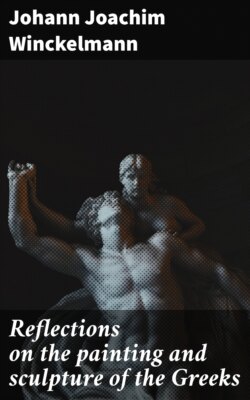Читать книгу Reflections on the painting and sculpture of the Greeks - Johann Joachim Winckelmann - Страница 6
На сайте Литреса книга снята с продажи.
II. Contour.
ОглавлениеTable of Contents
But even supposing that the imitation of Nature could supply all the artist wants, she never could bestow the precision of Contour, that characteristic distinction of the ancients.
The noblest Contour unites or circumscribes every part of the most perfect Nature, and the ideal beauties in the figures of the Greeks; or rather, contains them both. Euphranor, famous after the epoch of Zeuxis, is said to have first ennobled it.
Many of the moderns have attempted to imitate this Contour, but very few with success. The great Rubens is far from having attained either its precision or elegance, especially in the performances which he finished before he went to Italy, and studied the antiques.
The line by which Nature divides completeness from superfluity is but a small one, and, insensible as it often is, has been crossed even by the best moderns; while these, in shunning a meagre Contour, became corpulent, those, in shunning that, grew lean.
Among them all, only Michael Angelo, perhaps, may be said to have attained the antique; but only in strong muscular figures, heroic frames; not in those of tender youth; nor in female bodies, which, under his bold hand, grew Amazons.
The Greek artist, on the contrary, adjusted his Contour, in every figure, to the breadth of a single hair, even in the nicest and most tiresome performances, as gems. Consider the Diomedes and Perseus of Dioscorides[8], Hercules and Iole by Teucer[9], and admire the inimitable Greeks.
Parrhasius, they say, was master of the correctest Contour.
This Contour reigns in Greek figures, even when covered with drapery, as the chief aim of the artist; the beautiful frame pierces the marble like a transparent Coan cloth.
The high-stiled Agrippina, and the three vestals in the royal cabinet at Dresden, deserve to be mentioned as eminent proofs of this. This Agrippina seems not the mother of Nero, but an elder one, the spouse of Germanicus. She much resembles another pretended Agrippina, in the parlour of the library of St. Marc, at Venice[10]. Ours is a sitting figure, above the size of Nature, her head inclined on her right hand; her fine face speaks a soul “pining in thought,” absorbed in pensive sorrow, and senseless to every outward impression. The artist, I suppose, intended to draw his heroine in the mournful moment she received the news of her banishment to Pandataria.
The three vestals deserve our esteem from a double title: as being the first important discoveries of Herculaneum, and models of the sublimest drapery. All three, but particularly one above the natural size, would, with regard to that, be worthy companions of the Farnesian Flora, and all the other boasts of antiquity. The two others seem, by their resemblance to each other, productions of the same hand, only distinguished by their heads, which are not of equal goodness. On the best the curled hairs, running in furrows from the forehead, are tied on the neck: on the other the hair being smooth on the scalp, and curled on the front, is gathered behind, and tied with a ribband: this head seems of a modern hand, but a good one.
There is no veil on these heads; but that makes not against their being vestals: for the priestesses of Vesta (I speak on proof) were not always veiled; or rather, as the drapery seems to betray, the veil, which was of one piece with the garments, being thrown backwards, mingles with the cloaths on the neck.
’Tis to these three inimitable pieces that the world owes the first hints of the ensuing discovery of the subterranean treasures of Herculaneum.
Their discovery happened when the same ruins that overwhelmed the town had nearly extinguished the unhappy remembrance of it: when the tremendous fate that spoke its doom was only known by the account which Pliny gives of his uncle’s death.
These great master-pieces of the Greek art were transplanted, and worshipped in Germany, long before Naples could boast of one single Herculanean monument.
They were discovered in the year 1706 at Portici near Naples, in a ruinous vault, on occasion of digging the foundations of a villa, for the Prince d’Elbeuf, and immediately, with other new discovered marble and metal statues, came into the possession of Prince Eugene, and were transported to Vienna.
Eugene, who well knew their value, provided a Sala Terrena to be built expressly for them, and a few others: and so highly were they esteemed, that even on the first rumour of their sale, the academy and the artists were in an uproar, and every body, when they were transported to Dresden, followed them with heavy eyes.
The famous Matielli, to whom
His rule Polyclet, his chissel Phidias gave,
Algarotti.
copied them in clay before their removal, and following them some years after, filled Dresden with everlasting monuments of his art: but even there he studied the drapery of his priestesses, (drapery his chief skill!) till he laid down his chissel, and thus gave the most striking proof of their excellence.
